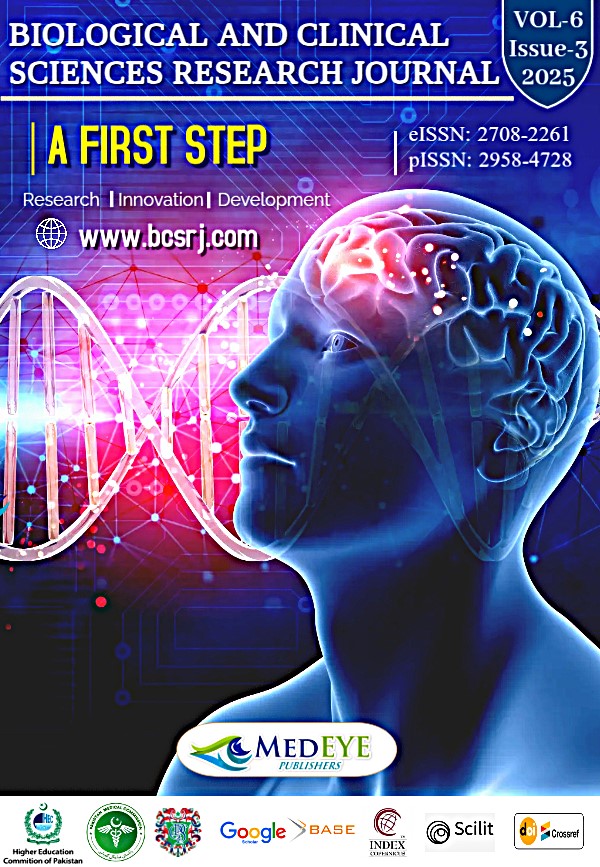To Study the Health-Related Quality of Life (HRQOL) in Children Presenting with Guillain-Barré Syndrome (GBS) in a Tertiary Care Hospital
DOI:
https://doi.org/10.54112/bcsrj.v6i3.1609Keywords:
Guillain-Barré Syndrome, Pediatrics, Quality of Life, Disability Evaluation, Cross-Sectional StudiesAbstract
Guillain-Barré Syndrome (GBS) is a rare and potentially life-threatening neurological disorder caused by an aberrant autoimmune response, leading to acute inflammation and damage to the peripheral nerves. Objective: The purpose of this study is to provide a comprehensive description of the impact of GBS on children, including functional disability and health-related quality of life, using the Hughes score. Methodology: This Cross-sectional observational study was conducted in the inpatient and outpatient departments of the Pakistan Institute of Medical Sciences Children's Hospital, Islamabad. Seventy-four children aged 1- 12 with GBS were recruited and followed for 1 year. Clinical characteristics of the disease, functional disability score, and HRQOL were reported at 3 and 6 months. Results: The Study showed a male predominance (78.4%) and the majority aged < 5 years (47.3%). Seasonal variation revealed the highest incidence during winter (62.2%), followed by summer (18.9%). Preceding symptoms included upper respiratory tract infections (35.1%) and diarrhea (18.9%); the rest of the children had no preceding risk factors. The clinical presentation of Guillain-Barré Syndrome (GBS) in the study cohort was dominated by limb weakness (100%) and areflexia (100%), with muscle pain also being prevalent (83.8%). Complications included cranial nerve palsies (41.9%) and autonomic instability (55.4%). At discharge, 50% required walking assistance, and 44.6% were bedridden or chair-bound. Over six months, significant functional improvements were observed, with 86.1% having normal function and only 8.3% still needing walking assistance. Health-related quality of life assessments showed marked physical, emotional, and social enhancements over three and six months. However, two patients (2.7%) experienced rapid disease progression leading to death, underscoring the severity of GBS despite overall positive outcomes. Conclusion: It is concluded that Guillain-Barré Syndrome (GBS) significantly impacts the health-related quality of life (HRQOL) in children, affecting their physical, emotional, and social well-being.
Downloads
References
Chand P, Jan F, Kaleem S, Yousafzai MT, Ibrahim S. Description of Guillain-Barre syndrome based on clinical features using Hughes scoring system among children in Karachi, Pakistan. Asia Pacific Journal of Clinical Trials: Nervous System Diseases. 2017 Apr 1;2(2):45.
Ali S, Rehman MZU, Sultan T. Spectrum of Guillain-Barré syndrome in children. Pakistan Journal of Neurological Sciences (PJNS). 2017;12(1):20-4.
Korinthenberg R, Trollmann R, Felderhoff-Müser U, Bernert G, Hackenberg A, Hufnagel M, Pohl M, Hahn G, Mentzel HJ, Sommer C, Lambeck J. Diagnosis and treatment of Guillain-Barré Syndrome in childhood and adolescence: An evidence- and consensus-based guideline. European Journal of Paediatric Neurology. 2020 Mar 1;25:5-16.
Samar SS, Ahmed SI, Bareeqa SB, et al. Guillain–Barré syndrome in Pakistan: A short review of literature. J Neurol Neurorehabil Res. 2018;3(1):34-3
Gupta PK, Singhi P, Singhi S, Kasinathan A, Sankhyan N. How different is AMAN from AIDP in childhood GBS? A prospective study from North India. The Indian Journal of Pediatrics. 2019 Apr 10;86:329-34.
Al Rumayyan Muhammad T Alrifai Mahmoud Salam and Adel F Almutairi SAWAADB-AA. Prevalence and outcomes of Guillain-Barré syndrome among,pediatrics in Saudi Arabia: a 10-year retrospective study [Internet]. https://www.ncbi.nlm.nih.gov/pmc/. 2019 [cited 2019 Mar 1]. Available from: https://www.ncbi.nlm.nih.gov/pmc/articles/PMC6400135/
Toopchizadeh V, Barzegar M, Taleschian-Tabrizi N, Pashazadeh F, Rashedi N, Chahvechi-Akbari M, Noori O. Long-Term Disability and Poor Outcome Predictors of Guillain-Barre Syndrome in Children: A Systematic Review. Journal of Pediatrics Review. 2023 Jan 10:0-.
Charlton, M., Sims, M., Coats, T., & Thompson, J. (2020). Intensive Care Society State of the Art. Journal of the Intensive Care Society, 21(2 Supplement 1), 225.
Hammoudeh F, Perwaiz MK, Patolia S, Schmidt FM, Neupane N, Gulati N, Enriquez D, Quist J, Zahir M, Kennedy E. Diffuse alveolar haemorrhage with ANCA associated vasculitis: review of literature. Br J Med Pract. 2011 Mar 1;4(1):a402.
Jin M, Zhao L, Liu J, Geng W, Zhao Z, Li C, et al. Association between the Rate of Treatment response and Short-Term Outcomes in Childhood Guillain-Barré Syndrome. Frontiers in Neurology [Internet]. 2021 Nov 5;12. Available from: https://pmc.ncbi.nlm.nih.gov/articles/PMC8602365/
Marsac ML, Alderfer MA. Pediatric Quality of Life Inventory (PEDSQL). In: Springer eBooks [Internet]. 2020. p. 1640–2. Available from: https://doi.org/10.1007/978-3-030-39903-0_974
Demurtas, J., Schoene, D., Torbahn, G., Marengoni, A., Grande, G., Petrovic, M., Maggi, S., Cesari, M., Lamb, S., Soysal, P. and Sieber, C., 2020. Physical activity and exercise in dementia: an umbrella review of intervention and observational studies. In 16th International E-Congress of the European Geriatric Medicine Society (Vol. 11, No. Suppl. 1, pp. S167-S168). Springer.
Shibeshi MS, Mengesha AA, Gari KT. Pediatric Guillain–Barré Syndrome in a resource limited setting: clinical features, diagnostic and management challenges, and hospital outcome. Pediatric Health Medicine and Therapeutics. 2023 Mar 1;Volume 14:107–15. Available from: https://doi.org/10.2147/phmt.s401461
Levison LS, Thomsen RW, Markvardsen LK, Christensen DH, Sindrup SH, Andersen H. Pediatric Guillain-Barré syndrome in a 30-Year nationwide cohort. Pediatric Neurology [Internet]. 2020 Mar 10;107:57–63. Available from: https://doi.org/10.1016/j.pediatrneurol.2020.01.017
Meshram RM, Bokade CM, Merchant S, Abhisheik S, Agrawal H, Dhakne S. Clinical profile of childhood Guillain-Barre Syndrome. Pediatric Review International Journal of Pediatric Research. 2016 Jun 30;3(6):427–32. Available from: https://pediatrics.medresearch.in/index.php/ijpr/article/view/131
Kalra V, Sankhyan N, Sharma S, Gulati S, Choudhry R, Dhawan B. Outcome in childhood Guillain-Barré syndrome. The Indian Journal of Pediatrics . 2009 Apr 16;76(8):795–9. Available from: https://doi.org/10.1007/s12098-009-0125-y
Doets AY, Verboon C, Van Den Berg B, Harbo T, Cornblath DR, Willison HJ, et al. Regional variation of Guillain-Barré syndrome. Brain. 2018 Aug 10;141(10):2866–77. Available from: https://doi.org/10.1093/brain/awy232
Guo F, Yao QY, Wu XH, Guo HX, Su XL, Zhou JF, et al. Clinical characteristics of Guillain-Barré syndrome in Shenzhen: a retrospective study. BMC Neurology . 2025 Feb 21;25(1). Available from: https://doi.org/10.1186/s12883-025-04061-3
Dimachkie MM, Barohn RJ. Guillain-Barré syndrome and variants. Neurologic Clinics. 2013 Feb 19;31(2):491–510. Available from: https://doi.org/10.1016/j.ncl.2013.01.005
Ryan MM. Guillain–Barré syndrome in childhood. Journal of Paediatrics and Child Health . 2005 May 1;41(5–6):237–41. Available from: https://doi.org/10.1111/j.1440-1754.2005.00602.x
Van Den Berg B, Bunschoten C, Van Doorn PA, Jacobs BC. Mortality in Guillain-Barré syndrome. Neurology . 2013 Apr 11;80(18):1650–4. Available from: https://doi.org/10.1212/wnl.0b013e3182904fcc
Adhikari AD, Shinde AP, Siddhu SKG, Gajre MP. Study of clinical profile and outcome in children aged 1-12 years presenting with Guillain Barre syndrome. International Journal of Contemporary Pediatrics. 2023 Apr 27;10(5):685–90. Available from: https://doi.org/10.18203/2349-3291.ijcp20231144
Chaweekulrat P, Sanmaneechai O. Prognostic model for time to achieve independent walking in children with Guillain-Barré syndrome. Pediatric Research. 2022 Feb 15;92(5):1417–22. Available from: https://doi.org/10.1038/s41390-021-01919-3
Barzegar M, Toopchizadeh V, Maher MHK, Sadeghi P, Jahanjoo F, Pishgahi A. Predictive factors for achieving independent walking in children with Guillain-Barre syndrome. Pediatric Research. 2017 Apr 19;82(2):333–9. Available from: https://doi.org/10.1038/pr.2017.67
Devi AK, Randhawa MS, Bansal A, Angurana SK, Malhi P, Nallasamy K, et al. Long-Term Neurological, Behavioral, Functional, Quality of Life, and School Performance Outcomes in Children with Guillain Barre Syndrome Admitted to PICU. SSRN Electronic Journal. 2022 Jan 1; Available from: https://papers.ssrn.com/sol3/papers.cfm?abstract_id=4133371.
Downloads
Published
How to Cite
Issue
Section
License
Copyright (c) 2025 Sara Ambreen, Rehmana Waris, Faiza Qayyum, Muhammad Tariq, Sana Ejaz, Rashiqa Saadat

This work is licensed under a Creative Commons Attribution-NonCommercial 4.0 International License.








